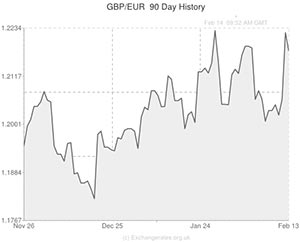
The Pound to Euro exchange rate (GBP/EUR) struck a near-one-year high of 1.2225 yesterday as investors continued to send Sterling higher in light of the latest Bank of England Quarterly Inflation report.
The Pound powered its way higher across the board in reaction to the BoE statement because, for the first time, Governor Mark Carney officially signalled that interest rates could be raised by Q2 2015. Sterling was also boosted by the Bank’s decision to upgrade its British GDP forecasts for 2014 from 2.8% to 3.4%.
The Sterling to Euro exchange rate (GBP/EUR) remained relatively unmoved by data yesterday morning showing that German CPI inflation held steady at 1.3% during January. The single currency could have weakened had the Consumer Price Index tumbled as this would have put more pressure on the European Central Bank to ease monetary policy further.
The Euro also proved resilient to a report from the ECB signaling that inflation is likely to remain below the 2.0% target for an extended period of time. 2014 CPI estimates were revised lower from 1.5% to 1.1% and 2015 forecasts were downgraded from 1.6% to 1.4%. By 2016 inflation is expected to have risen to 1.7%.
Political developments also threatened to destabilise the single currency yesterday, as Italian Prime Minister Enrico Letta was ousted by another member of his own party. Mr Letta is expected to hand in his resignation notice later today due to Democratic Party leader Matteo Renzi’s decision to withdraw support for Letta’s 10-month old coalition government.
It seems that with Silvio Berlusconi out of the way, investors are far less worried by the prospect of political uncertainty in the currency bloc’s third largest economy.
Later this morning Eurozone GDP data is forecast to show that economic growth accelerated from 0.1% to 0.3% during the final three months of 2013. If Q4 Gross Domestic Product matches analysts’ expectations then GBP/EUR could slide slightly from its current level of elevation. However, if the growth report shows any signs of the Eurozone recovery slowing, then Sterling has the potential to rise to a fresh yearly high of 1.2242.
Also on the agenda today is Industrial Production data out of the USA, which is predicted to show that output decelerated from 0.4% to 0.2% during January. The University of Michigan Confidence Index is also anticipated to see a dip, from 81.2 to 80.5.
If the American ecostats come in worse-than-expected it is entirely possible that the Pound to US Dollar exchange rate could surge to a fresh 2.5-year high. GBP/USD hit 1.6673 yesterday, which is its highest level since April 2011.

Comments are closed.